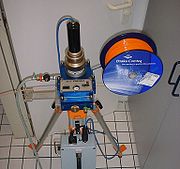
Microducts
Encyclopedia

Traditional duct installation
For telecommunications cables can be installed in water, in air or underground. In the latter case the cables might be direct buried or installed in ducts. The first is more common for copper balanced cables, the latter for fibre optic cables. The ducts in which the fibre optic cables are installed are usually made of polyethylenePolyethylene
Polyethylene or polythene is the most widely used plastic, with an annual production of approximately 80 million metric tons...
. They have a size ranging from typically 25 mm to 100 mm. Sometimes they are installed as subducts in larger ducts. These larger ducts can also consist of other materials, like concrete. The installation of fibre optic cables in ducts can be done by pulling or by cable jetting
Cable jetting
Cable jetting is a technique to install cables in ducts. It is commonly used to install cables with optical fibers in underground polyethylene ducts and is an alternative to pulling.-Pulling:...
.
Problems with fibre optic cables
It is more difficult to make branching fibre optic networks in the access network than it is for copper balanced cables. Splicing optical fibres is much more difficult than connecting copper wires. In Fibre to the Home (FTTH), where a lot of branches are present in the network, an Optical Distribution Network is used to branch the cables from a roadside cabinetOutside plant
In telecommunication, the term outside plant has the following meanings:*In civilian telecommunications, outside plant refers to all of the physical cabling and supporting infrastructure , and any associated hardware located between a demarcation point in a switching facility and a demarcation...
or pit that contains optical equipment and is fed from the Central Office
Microduct cabling

Cable jetting
Cable jetting is a technique to install cables in ducts. It is commonly used to install cables with optical fibers in underground polyethylene ducts and is an alternative to pulling.-Pulling:...
for example. Bundles of microducts can also be factory pre-installed. The microducts can be branched very easily in the network. At any place of choice a window cut is made in the protective duct and the microduct of choice is cut. This microduct is then connected, using a simple push/pull connector, to a microduct that branches to the desired location. After all connections are made an individual microduct path has been created in the network. A microduct cable can then be jetted through the microduct, without the need to make a splice.
Advantages over traditional cabling
- A branch can be made simply, any place any time.
- Low initial costs.
- The network can grow on demand.
- Easy to install microduct routes in occupied ducts.
- Easy to replace old cables through the network.
- Possibility to migrate from copper balanced cables to fibre optic cables.
Practice


